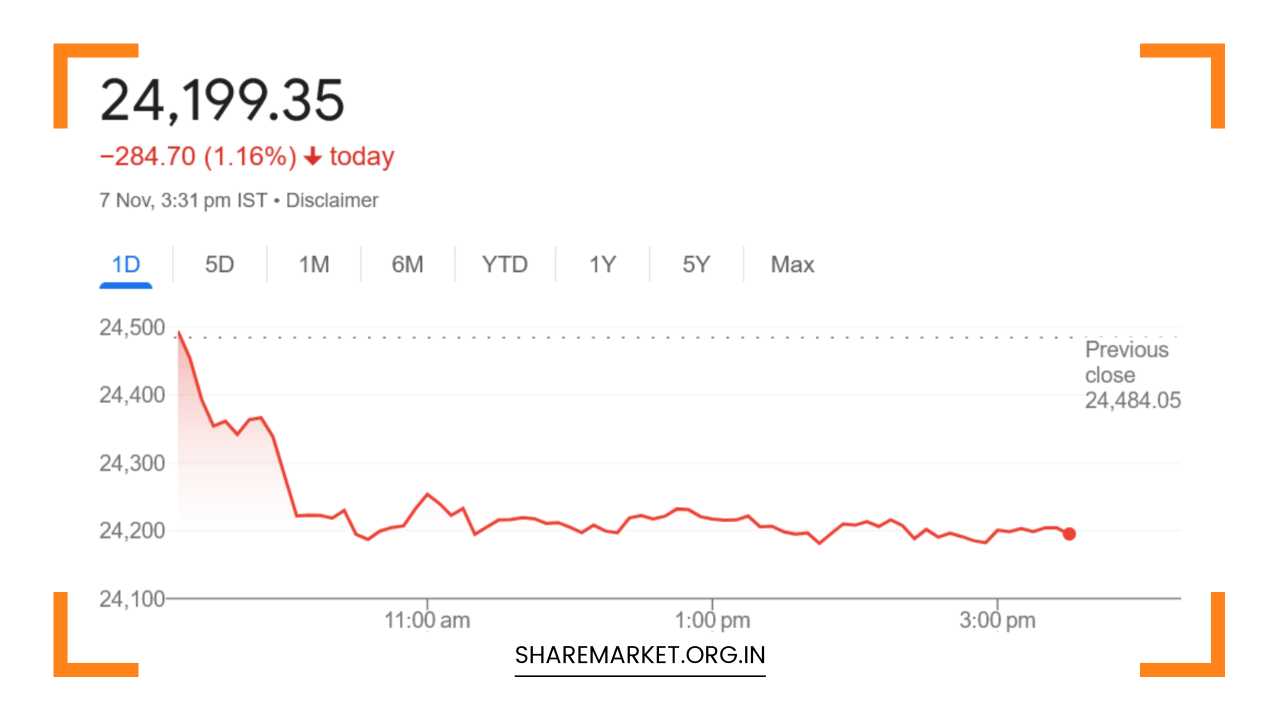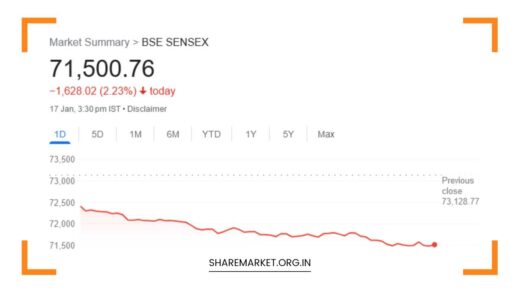Sensex Down 836 Points, Nifty at 24,199; Tomorrow Nifty Prediction

Tomorrow Nifty Prediction
Market Falls After Two Days of Gains: What to Expect for November 8
After two consecutive days of positive momentum, the Indian stock market witnessed a sharp decline on November 7, 2024.
The benchmark indices closed deep in the red, with a broad-based sell-off impacting most sectors, except for PSU banks, which managed to hold ground.
The day’s fall erased some of the gains from earlier in the week, leaving traders and investors questioning the market’s next move, especially with the volatility of global markets and economic concerns looming over India.
Market Overview: Nifty, Sensex and Sectoral Performance on November 7
At the close of the trading session, the Nifty 50 index ended at 24,199.35, down by 284.70 points or 1.16%.
The Sensex, the BSE benchmark, closed at 79,541.79, falling 836.34 points, or 1.04%. This decline came after the market had witnessed two days of consecutive gains, leaving investors uncertain about the near-term outlook.
The market breadth on November 7 was also negative, with 1,733 stocks advancing, 2,057 declining, and 93 remaining unchanged.
The sectoral indices displayed broad-based weakness, with almost every sector closing in the red. The Auto, Metal, Power, Telecom, Pharma, and Realty sectors were among the hardest hit, all falling by 1-2%.
The BSE Midcap and BSE Smallcap indices also saw declines, shedding around 0.5% each. The Nifty Bank index was particularly affected, closing 401 points lower at 51,917, signaling weakness in the financial sector.
On the stock front, some of the worst performers included Nailco Industries, Trent, Shriram Finance, Tech Mahindra, and Grasim Industries, which saw significant declines.
On the other hand, Apollo Hospitals, HDFC Life, SBI, TCS, and L&T stood out as relative outperformers, with their shares managing to buck the overall downward trend.
Market Sentiment: Global and Domestic Influences
The day’s sharp decline came despite some positive cues from global markets. However, domestic factors, including the weekly expiry of derivatives contracts, played a significant role in the subdued performance.
In addition, global economic developments are expected to have a substantial impact on Indian markets over the coming weeks.
According to VK Vijaykumar, Chief Investment Strategist at Geojit Financial Services, one of the major factors influencing global market sentiment is the U.S. economic policy, particularly former President Donald Trump’s “America First” stance.
Trump has repeatedly criticized trade relations with China and other nations and has proposed imposing 60% tariffs on Chinese imports and 10-20% tariffs on imports from other countries.
If these measures are implemented, it could lead to a significant increase in global inflation, affecting global supply chains and raising input costs for many industries.
For the U.S. Federal Reserve, this could mean a reconsideration of its policy to cut interest rates. With inflationary pressures on the rise, the Fed could be forced to maintain or even raise rates to curb price increases, which would likely have a negative impact on equity markets globally, including in India.
Rising interest rates in the U.S. could also lead to capital outflows from emerging markets, further pressuring the Indian stock market.
Back home, despite some positive global cues, Aditya Gaggar, Director at Progressive Shares, pointed out that Indian markets started weak on the day of the weekly expiry, remaining in a limited range with a negative bias throughout the session.
The broader market sentiment was also weighed down by concerns over global economic growth, along with domestic challenges like inflation, high interest rates, and the pace of economic recovery.
Technical Outlook for Nifty: What to Watch on November 8
From a technical standpoint, the Nifty index has formed a bearish engulfing pattern on the daily chart, which typically signals a potential continuation of the downtrend.
The market failed to maintain its gains from the previous sessions and reversed sharply, making this pattern a cause for concern among traders.
However, analysts believe that the Nifty could still be forming the right shoulder of an inverted head and shoulders pattern, a bullish reversal pattern, with the neckline at 24,500.
This suggests that if the Nifty manages to break above this level, it could initiate a fresh uptrend, with targets potentially extending toward the 25,000-25,200 range.
On the downside, the 24,000 psychological level remains crucial for the Nifty. If the index slips below this support, it could lead to further downside risk, with the next potential support levels seen at 23,800 and 23,500.
Traders will be keenly watching the market’s ability to hold above 24,000, as a break below this level could signal a deeper correction in the short-term.
Key Levels to Watch on November 8
- Immediate resistance: 24,500 (Neckline of inverted head and shoulders pattern)
- Support levels: 24,000 (Psychological support), 23,800 (Intermediate support), 23,500 (Strong support)
If the Nifty holds above 24,000, there could be some potential for a rebound or sideways movement. However, a decisive break below this level could lead to a test of the 23,800-23,500 range, which could attract fresh selling pressure.
What Investors Should Expect on November 8
Looking ahead to November 8, the market could see a continuation of the volatile price action.
Investors should remain cautious and closely monitor global cues, especially U.S. economic developments, which are likely to influence sentiment in Indian equities.
With the Fed’s stance on interest rates and global trade tensions being key concerns, Indian markets may face increased pressure if the global risk-off sentiment continues.
In addition, domestic factors such as quarterly earnings reports, inflation data, and any policy changes from the Indian government or the Reserve Bank of India (RBI) could add further volatility to the market.
Given the current market uncertainty, it is advisable for investors to exercise caution, focus on sectoral rotation, and ensure a diversified portfolio to manage risk effectively.
For traders, the 24,500 resistance level on the Nifty will be crucial. A break above this level could suggest a short-term reversal, while a failure to surpass this level, along with a breach of the 24,000 support, could signal further downside in the near term.
In summary, the Indian stock market’s near-term outlook remains uncertain, with both global and domestic factors influencing sentiment.
While the Nifty is attempting to form a bullish reversal pattern, it faces immediate resistance and key support levels that traders and investors should closely monitor.
Given the volatility and mixed global signals, caution remains key in navigating the market in the coming sessions.

















